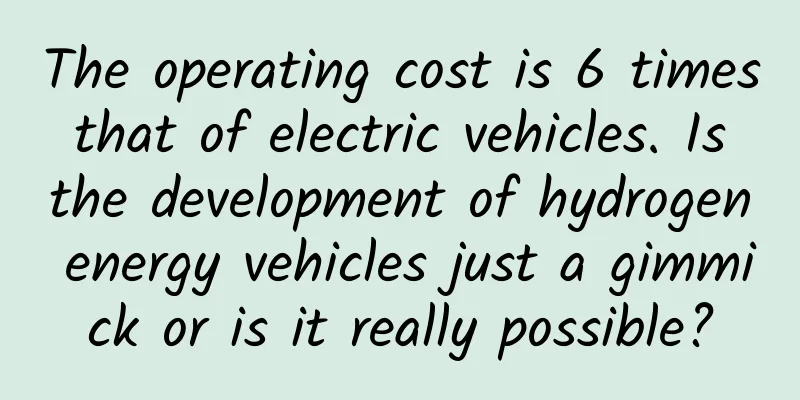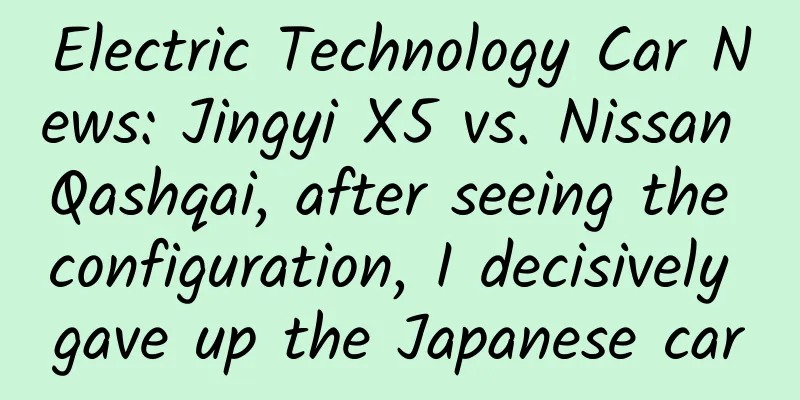The operating cost is 6 times that of electric vehicles. Is the development of hydrogen energy vehicles just a gimmick or is it really possible?

|
Last September, China proposed for the first time a new goal of "striving to achieve carbon peak by 2030 and carbon neutrality by 2060" to address climate change. At the same time, carbon peak and carbon neutrality were written into the government work report for the first time. There is no doubt that reducing carbon emissions will become the focus of the future energy industry, and the transformation of the automotive industry will also become extremely critical. Hydrogen energy, as an absolutely clean "perfect green energy", may play an important role in my country's efforts to achieve carbon peak and carbon neutrality. Hydrogen energy, the next industry trend? After years of development, electric vehicles have now been accepted by consumers. A large part of the reason why electric vehicles can be popularized so quickly is due to the intervention of subsidy policies from relevant state departments. According to the latest data from market research firm Canalys, global electric vehicle sales surged 39% year-on-year to 3.1 million units in 2020. Canalys predicts that electric vehicle sales will increase to 30 million units in 2028; by 2030, the electric vehicle market will account for nearly half of global passenger car sales. Faced with such a huge potential in the electric vehicle market, major automakers have not completely focused on the electric vehicle market, but have begun to take into account the development of the hydrogen energy vehicle market. For example, SAIC Motors launched the fuel cell MPV SAIC Maxus EUNIQ 7 and announced the simultaneous implementation of its "hydrogen strategy". SAIC Motors has clearly stated that it will achieve the four major goals of "10, 100, 1,000 and 10,000" by 2025, namely, its subsidiary JE Hydrogen Technology will reach a market value of 10 billion yuan, a fuel cell R&D and operation team of more than 1,000 people will be established, and a fuel cell vehicle production and sales scale of 10,000 vehicles will be formed, with a market share of more than 10%. The scale of SAIC's "hydrogen strategy" shows that SAIC attaches great importance to the development of hydrogen energy. In addition to car companies paying attention to the development of hydrogen energy vehicles, relevant government departments have also begun to pay attention to the development of hydrogen energy vehicles. On May 9, 2020, the Ministry of Finance issued a draft opinion on "Carrying out Demonstration and Promotion of Fuel Cell Vehicles", promoting more than 1,000 fuel cell vehicles that meet relevant technical indicators. The issuance of this draft opinion has given everyone hope for the development of hydrogen energy vehicles. It should be noted that during 2019, the Ministry of Finance had repeatedly released the signal that "hydrogen fuel cell vehicle subsidies will be withdrawn according to established policies." The reason why relevant departments attach so much importance to hydrogen energy and major automobile companies are also accelerating the development of hydrogen energy vehicles is closely related to the advantages of hydrogen energy. As the most abundant element in the universe, hydrogen accounts for 75% of the mass of the universe and ranks third in reserves on Earth. Large reserves ensure its adequacy as an energy supply. Taking the Japanese government as an example, in order to solve the problems of excessive import of fossil energy, difficulties in restarting nuclear power, and general domestic renewable energy endowment, the Japanese government attaches great importance to the development of the hydrogen energy industry. In 2019, the Ministry of Economy, Trade and Industry (METI) of Japan proposed the "Strategic Roadmap for Hydrogen Energy and Fuel Cells". In addition to being sufficient, hydrogen has the highest calorific value among common fuels (142KJ/g), which is about 3 times that of oil and 4.5 times that of coal. In other words, when consuming the same mass of oil, coal and hydrogen, hydrogen provides the most energy. This characteristic is an important factor in achieving lightweight in automobiles, aerospace, etc. In general, the development of hydrogen energy vehicles is of great significance to the automotive industry, and can even break the shackles of electric vehicle range. Perhaps many people don’t know that in the past decade, the energy density of lithium batteries has increased by 2.5 times, which is close to the safety limit. It is very difficult to increase it again. If car companies forcibly increase the battery life, it will inevitably cause serious safety hazards. Hydrogen fuel vehicles avoid the shortcomings of pure electric vehicles and are even very similar to traditional fuel vehicles. For example, refueling with hydrogen and refueling only takes a few minutes. In this case, car owners do not need to worry about finding charging piles, and they also save the time required for charging. Although many electric vehicles on the market now support fast charging, which can charge 80% in 30 minutes, long-term use will still affect the user's efficiency. Therefore, hydrogen-powered vehicles may be able to replace electric vehicles with their own advantages and become the energy vane of the next automotive era. Hydrogen-powered vehicles are difficult to popularize Many people are very curious about why the more environmentally friendly hydrogen-powered vehicles are crushed by electric vehicles and fail to become the mainstream of the new energy vehicle market. 91che believes that hydrogen-powered vehicles cannot be as popular as electric vehicles today, mainly due to the following three reasons: 1. High cost The technical principle of electric vehicles is relatively simple, the R&D cost is low, and the industrial chain is even shorter than that of fuel vehicles. This is why there are so many new car-making forces in the automobile market after the introduction of the new energy vehicle subsidy policy. In contrast, the technical development difficulty, industrial chain and the resulting costs of hydrogen energy vehicles are very high. Among them, the precious metal platinum is needed as a catalyst in the process of hydrogen fuel cell power generation, but platinum resources are relatively scarce and the price is also very high. In 2013, the mass-produced hydrogen fuel cell vehicle iX35 FCV under Hyundai of South Korea was priced at RMB 855,000; Toyota's Mirai spent a lot of effort to minimize the use of platinum, but its price was still as high as RMB 550,000. In addition, the price of hydrogen energy is much higher than that of ordinary electricity. Tests have shown that its use cost is more than 6 times that of electricity. 2. Energy Efficiency Compared with electric vehicles, hydrogen-powered vehicles are less efficient. Industry experts have calculated the efficiency of hydrogen-powered vehicles and electric vehicles. The energy efficiency loss of electric vehicles mainly includes the loss of about 5% of the power supply at the vehicle charging location, the loss of about 10% in the charging and discharging of the battery, and finally the loss of 5% at the motor location, with a total loss of 20%. Since hydrogen-powered vehicles integrate charging devices in the vehicle, the final driving method is the same as that of pure electric vehicles, which are all driven by motors. According to tests conducted by relevant testing agencies, if 100 degrees of electricity is used to produce hydrogen, then stored, transported, added to the vehicle, and then converted into electricity to drive the motor, the utilization rate of the electricity is only 38%. If the calculation starts from the time hydrogen is injected into the vehicle, the utilization rate is only 57%. In other words, no matter how you calculate it, the energy utilization rate of hydrogen-powered vehicles is far lower than that of electric vehicles. 3. Supporting Facilities As of January 2021, the total number of charging infrastructure in my country has reached 1.716 million, and the number of public charging piles has reached 810,903. In contrast, as of the end of 2020, China has built 104 hydrogen refueling stations. According to the "White Paper on China's Hydrogen Energy and Fuel Cell Industry", China will build 200 hydrogen refueling stations in 2025, which will have a great impact on the popularization speed of hydrogen energy vehicles. According to information obtained by 91che, the low penetration rate of hydrogen stations is closely related to their construction costs and operating costs. At present, it only costs about 1 million yuan to build an ordinary charging station, and even Tesla's super charging station only costs about 2 million yuan. The investment cost of building a 35MPa, 500kg/d fixed hydrogen refueling station is about 15-20 million yuan. In comparison, the construction cost of charging stations is lower, and the speed of popularization is naturally faster. In order to support the development of hydrogen energy vehicles, according to the development plan in the "China Hydrogen Energy Industry Infrastructure Development Blue Book", China will build 1,000 hydrogen refueling stations by 2030. As a large country with an area of 9.6 million square kilometers, building 1,000 hydrogen refueling stations in ten years is simply a drop in the bucket for the development of hydrogen energy vehicles in China. Electric vehicles will still be mainstream How long will it take for the era of hydrogen-powered cars to arrive? 91che believes that this is a question worth thinking about. Great Wall Motors has proposed three development stages for reference: the first stage is from 2021 to 2025, which will usher in the hydrogen era and focus on hydrogen demonstration; the second stage is from 2025 to 2035, which will develop the hydrogen economy and open up the hydrogen ecology; the third stage is from 2035 to 2050, which will build a hydrogen society and contribute to carbon neutrality. There is a saying in the automotive industry that 85% of hydrogen energy vehicle technology is controlled by Toyota. From the current situation, there is still a lot of work to be done for the technology mastered by domestic brands through independent research and development. The road to hydrogen energy is long. As a winner of Toutiao's Qingyun Plan and Baijiahao's Bai+ Plan, the 2019 Baidu Digital Author of the Year, the Baijiahao's Most Popular Author in the Technology Field, the 2019 Sogou Technology and Culture Author, and the 2021 Baijiahao Quarterly Influential Creator, he has won many awards, including the 2013 Sohu Best Industry Media Person, the 2015 China New Media Entrepreneurship Competition Beijing Third Place, the 2015 Guangmang Experience Award, the 2015 China New Media Entrepreneurship Competition Finals Third Place, and the 2018 Baidu Dynamic Annual Powerful Celebrity. |
<<: Opinion: China's television stations are being overturned much faster than the United States
Recommend
It took me 3 months just to conquer the Apple 2.1 package, and luckily I won!
At the end of the year, the review process sudden...
They are both iced coffee, why is cold brew more expensive than iced Americano?
In the hot summer, many people often drink a cup ...
In the K12 education industry, how to expand into lower-tier cities and acquire customers?
As the concept of sinking begins to penetrate int...
Microsoft exec says Xbox One was made for shooters
Although Wii U, PlayStation 4 and Xbox One are of...
How much does the Tianhe WeChat food ordering and takeaway app cost per year?
Recently, the epidemic in my hometown has become ...
WeChat blocks external links to multiple products including Zhihu, Kuaishou, and Pinduoduo
[[375761]] The WeChat Security Center has issued ...
With 100M broadband everywhere, why is our internet speed always slower than advertised?
Have you felt that the operators have increased sp...
This mountaintop observatory is painting the largest 3D picture of the universe
Author | Wang Qing Review | Ding Yi, Zhao Jingyua...
How much does a pound of chili pepper cost in 2022? Why is the price so high? Attached is the reason for the price increase!
Millet pepper is a multi-purpose pepper variety t...
How to get traffic from Tik Tok short videos
Tik Tok short video marketing is booming, how can...
An old man in the park "hangs" himself on the horizontal bar. Is it to treat cervical spondylosis?
Audit expert: Wang Linjue Deputy Chief Physician,...
WeChat adds "Rush" status: based on Kris Wu
WeChat status is a new feature of WeChat. After w...
Is global climate change causing the brain to become "out of control"?
Leviathan Press: In a previous article titled &qu...
Product operation, why is the product user retention rate so low?
As the traffic dividend gradually disappears, it ...
5 ideas for writing an executable plan for APP online promotion
When I was setting the topic, I wanted to write “...









